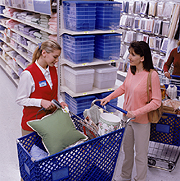The Bargain! Shop, a major Canadian-owned retail chain with over 250 stores, consistently meets its customer demands by offering brand-name products at the guaranteed lowest prices. That means it must constantly evaluate and change pricing in order to remain competitive.
With inventory changing weekly, The Bargain! Shop needed a flexible pricing strategy. Previously, store clerks consulted the service desk for prices, and then selected from pre-printed shelf labels. Those labels only included a price without a product description, which often confused customers about which items corresponded with which shelf prices.
Plus, the approach was inefficient for clerks, who had to spend time verifying pricing and checking inventory.
 The retailer sought a better way to manage pricing and stock visibility by integrating management software with mobile computing and printing operations like Zebra mobile printers.
The retailer sought a better way to manage pricing and stock visibility by integrating management software with mobile computing and printing operations like Zebra mobile printers.
In-aisle printing with mobile technology enhanced pricing accuracy, ensuring customers would see and pay the correct prices. It also made re-pricing much faster than before—typically in just a few seconds per product—so marking down products for major sales decreased from four hours to two hours.
Click here to learn how the retailer:
- Reduced price marking costs by 25 to 40 percent.
- Freed clerks’ time to focus on store appearance and customer service.
For more information on in-aisle mark downs, go here.


 The retailer sought a better way to manage pricing and stock visibility by integrating management software with mobile computing and printing operations like Zebra mobile printers.
The retailer sought a better way to manage pricing and stock visibility by integrating management software with mobile computing and printing operations like Zebra mobile printers.






![KPS_coupon[1]](https://zebrashelftalker.files.wordpress.com/2010/08/kps_coupon1.jpg?w=150&h=126)


